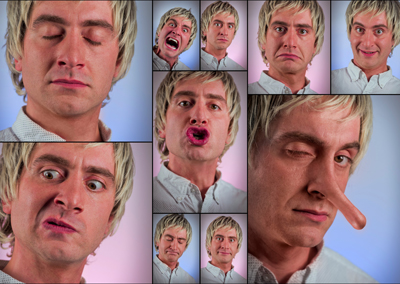Discovering the truth via micro expressions
Emotions make our lives worth living. And the quality of emotions determines our life quality.
Every relationship that we enter is characterized by emotions. Those can be positive and cause true happy moments by releasing endorphins. Or they are negative and stress hormones flow through our body and mind. Every action that we perform is eventually based on an emotion, as well as every decision that we take. Even rational and logical decisions give us a good feeling: a feeling of safety and the positive feeling that we made the right choice.
However, we or our conversation partners do not always want to show each other what we feel. There are situations where it feels uncomfortable to show emotions. Or it seems beneficial to hide emotions from our conversation partners. Therefore, we train how to use emotions in a selective way in order to put our negotiation partner into a required situation and reach consequently the desired goal. Who has not heard from the “competent” handshake or the “right” welcome that demonstrate self-confidence. The right sitting posture at the table to signal interest. Open hands to express trust. The slope of the head that suggests goodwill. Many heard from it, many trained it. Thus, we often do not know if what we observe really corresponds to the emotions of our conversation partner or is just supposed to show us a certain picture of the inner attitude.
If there just were explicit signals that could be clearly assigned to a certain emotion, assuring us that this one is authentic and not just pretended. These explicit signals exist. They are called basic emotions and became inter alia famous due to the great Tim Roth in the role of Carl Lightman in the TV show “Lie to me“. The show deals with exposing liars based on micro expressions.
Pioneer in the investigation of micro expressions is Paul Ekman, an American anthropologist and psychologist who became famous for his research in nonverbal communication and is nowadays among others consulting the FBI, CIA and security services. Ekman investigated facial impressions in countries like the USA, Japan and Papua New Guinea and found out that seven universal basic emotions exist. They are the same for all people, independent from character and cultural belonging. And we cannot control or train them as they are an immediate reaction of our emotional state, which might just show up in a fraction of a second in our facial expression. Those basic emotions are anger, sorrow, fear, surprise, disgust, contempt and joy.
How does the corresponding facial expression look like in this micro second?
Anger: our eyebrows contract and sink. Over the nasal bridge, between our eyebrows vertical wrinkles appear and the lower eyelids are tensed. The lips are clenched.
Sorrow: when we are sad our lips form a horse shoe with the aperture facing downwards. Our inner eyebrows and the eyelids pull upwards and our glance is without focus and empty.
Fear: We lift and contract the eyebrows at the same time. A horizontal wrinkle appears on our forehead. Our upper and lower eyelids are lifted, whereas latter are tensed. The mouth is open and the corners of the mouth are pulled downwards.
Surprise: clear signals for surprise are lifted eyebrows and a vertical wrinkle covering the whole forehead. Our eyelids are opened widely, the mouth is unclosed and the mandible falls down relaxed.
Disgust: The upper and lower lip are pulled upwards. Clear wrinkles appear on our nose bridge. Our eyebrows lower and wrinkles emerge under the eyes. Normally, the head is moving backwards.
Contempt: A relaxed facial expression and a single tensed, upwards pulled corner of the mouth are clear signs for contempt.
Joy: The corners of the mouth form a smile. Wrinkles are pulling from the nose bridge downwards to the corners of the mouth and smile wrinkles, so called crow’s feet, appear in the corners of the eye. By the way, that’s how true joy can be distinguished from pretended joy. If true joy is experienced the eyes laugh as well. At pretended joy, only the corners of the mouth move back and upwards.
Are those signals sufficient enough to reveal a lie? No! On the one hand, it is about discovering the truth and not about uncovering a lie. On the other hand, the micro expression tells us only that there is a basic emotion at the moment, but not why. For instance, fear can be shown from an employee having a conversation with his boss or from an attendee at an assessment. However, we do not know of what he is really afraid. Is it the fear that a lie is discovered or the fear that no one is believing him? Both is possible. To have certainty, further communication channels need to be evaluated. Those are body language, voice, linguistic style and verbal content. Only the consideration of those five channels as a whole, the congruence between content and context and the spontaneity between emotion and cognition really tells us if we have detected the truth or not.
All that information is sent on all five channels – of course only if speech is included. Otherwise, just two channels are sending information. We only face the challenge of receiving, interpreting and questioning all of them to obtain certainty. The good news is: our brain is able to receive all those information and signals. Only intensive training and praxis is needed to become an expert.
Gianni Liscia is one of the managing partners of Liscia Consulting GbR creatingLEADERS. With their headquarter in Paderborn, the Liscia Consulting is operating internationally as an expert company for leader creation in the past 17 years. The leader creators focus on a practical and pragmatic orientation of their work. Gianni Liscia is international certificated in detecting the truth by the Paul Ekman Institute.



